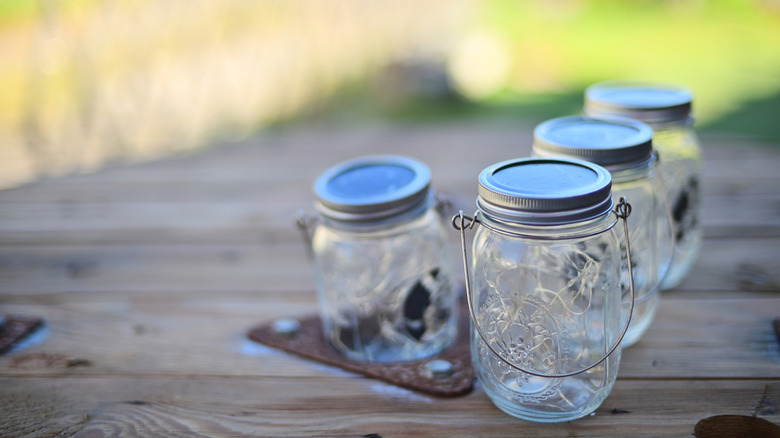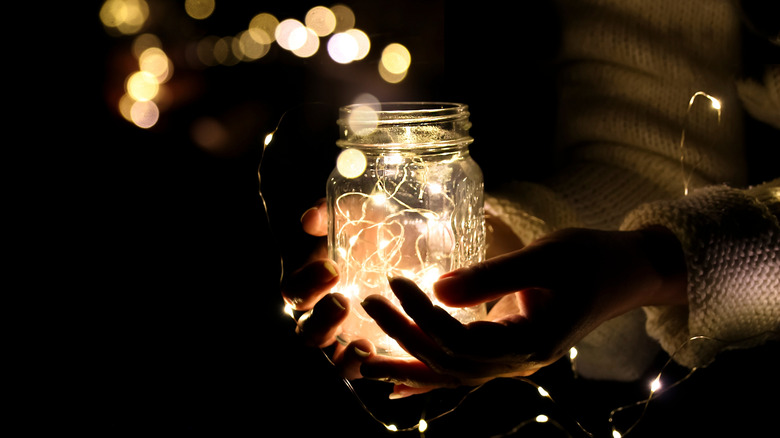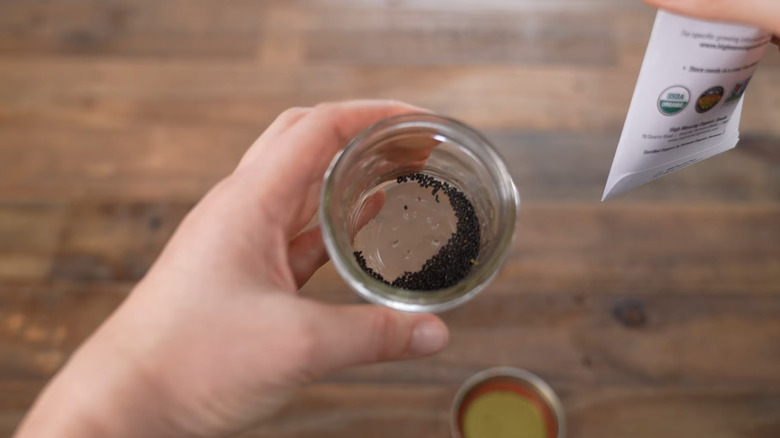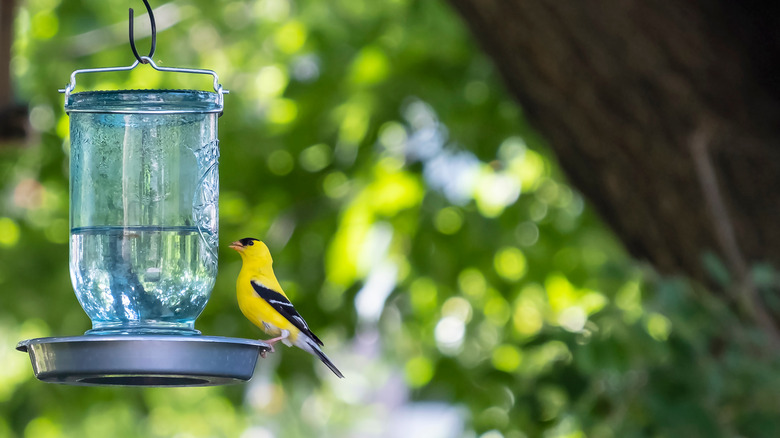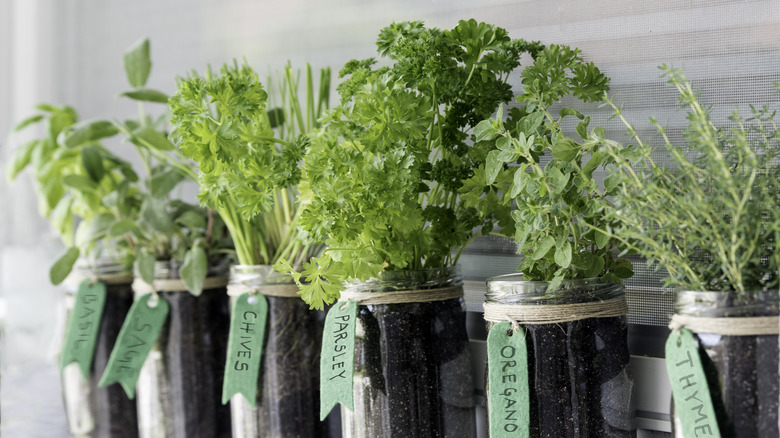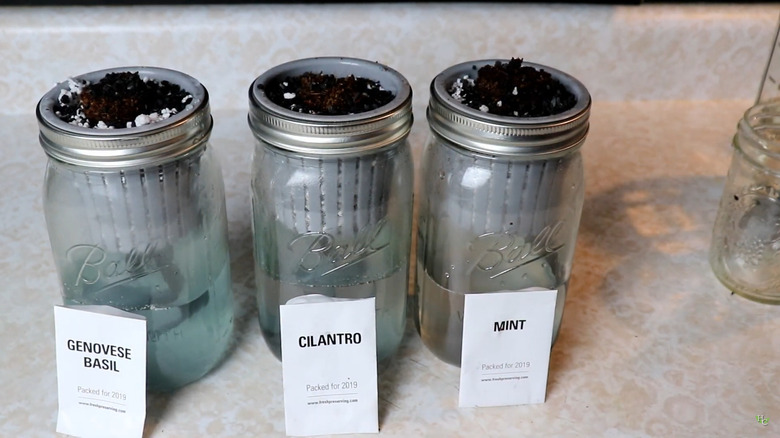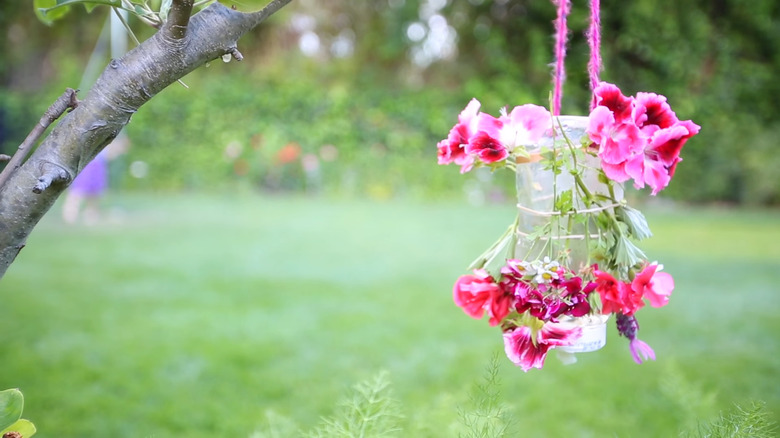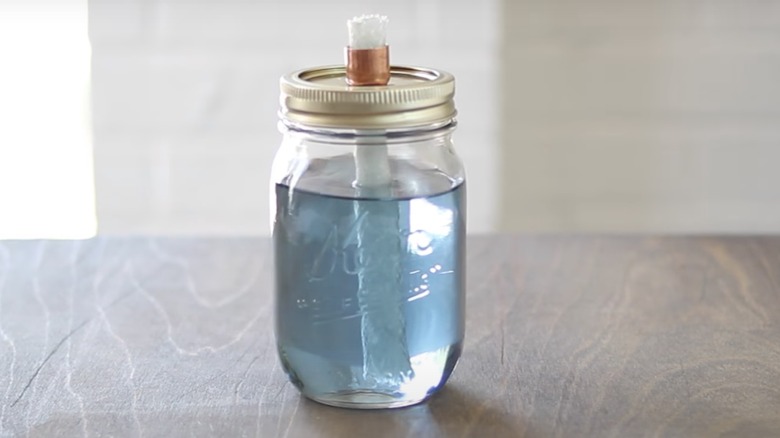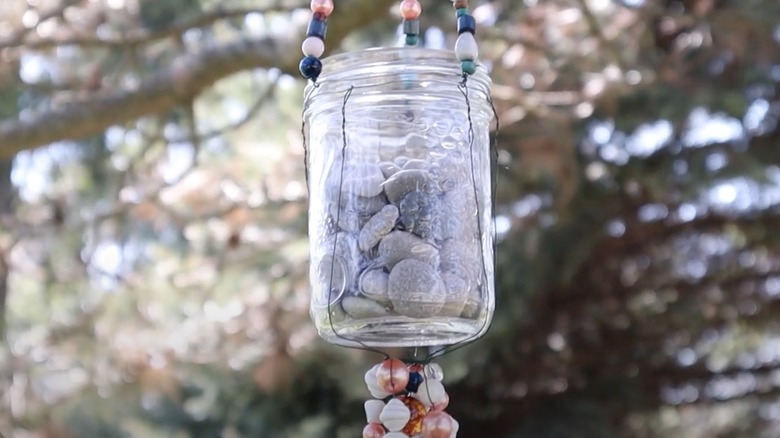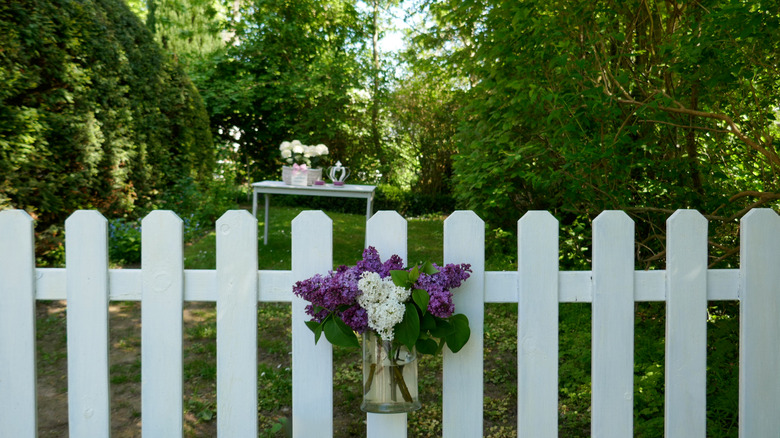Handy Ways To Use Old Mason Jars In Your Yard And Garden
We may receive a commission on purchases made from links.
Mason jars are a staple in many households. From storing food to doubling as cute, farmhouse-style cups or décor, there are countless ways Mason jars can be used in your home. But have you ever wondered if these handy jars could also be put to work in your yard or garden? Well, the answer is a resounding yes. Mason jars can be used in a variety of ways in your outdoor spaces. From welcoming birds to helping you grow your favorite herbs, or even creating budget-friendly lighting, Mason jars might just be the secret weapon you need to take your outdoor space to the next level.
For some of these projects, you might need to pick up a few additional supplies. But others you may be able to create with things you already have, like an unused pie tin or some beads that are hanging out at the bottom of your crafting box. If you've accumulated more Mason jars than you know what to do with, this article is for you. Keep reading to learn about nine handy ways you can repurpose your old jars to use them in your yard and garden.
Add a little light to your yard
Getting creative with your lighting can be the perfect way to spruce up your yard and/or garden, and Mason jars can help you do it. All you need for this quick and easy DIY project are a few Mason jars and some battery-powered string lights. Simply place a string of lights into each of your jars. You can also add some white sand or small pebbles to the bottom of each jar to cover the lights' battery packs. Turn the lights on, put the lids on your jars, and voilà! If you're feeling extra creative, you can even use different color lights to add a little flare.
In addition to being simple, this little hack is also very affordable. You can use Mason jars you already have lying around, and you can find battery-powered string lights for under $10 at Michael's. If you're willing to spend a little extra and want to create hanging lanterns, you can also pick up some Mason jar wire hanging handles from Amazon ($11.99 for 12). Or, you can save a few dollars and create a rope handle by securely wrapping cord around the jar mouth and attaching a loop for hanging.
Keep your seeds safe
If you spend a lot of time in your garden, you know how important proper seed storage is. Seeds can lose their viability when they aren't kept in the right conditions. Luckily, Mason jars offer a great solution for your storage needs. All you have to do is place your seeds (it's important to make sure they're dry) into a jar and close the lid. You can either decant loose seeds into the jar, or place packets of seeds directly inside. If you're worried about moisture from the air getting trapped in the jar, you can also pop in a couple of silica sachets, or pour some uncooked rice into the bottom. Be sure to keep your seed jar(s) somewhere that is cool and dark. Although most seeds will last fine at room temperature in moderate climates for up to a year, gardeners often recommend a place that doesn't get warmer than 60 degrees Fahrenheit if you plan on storing them for 12 months or more.
Mason jars are a great place to store seeds because rodents and bugs can't get into them. Keep in mind, however, that you should do some research on the specific types of seeds you plan to store to ensure you're keeping them in the most ideal conditions. If you are going to cold-stratify any seeds before planting, don't place the Mason jar directly into the freezer, unless it's a freezer-safe design.
Turn your yard into a hot spot for birds
Looking out of your window and seeing a beautiful bird in your yard or garden is a great feeling, and it's one that you can have more often with a little help from Mason jars. There are several ways you can use Mason jars to draw more birds to your yard. You can create birdfeeders that will have your favorite feathered friends flocking, or even DIY a drinking station. One of the easiest methods is to use a Mason jar with a hanging lid, which has an open hole in it. Fill the jar with bird seed, hang it from your favorite tree (or a pole), and keep an eye out for some songbirds.
One of the best things about using a Mason jar as a bird feeder or water station is that it's cost-effective, and there are plenty of methods you can use to put your own spin on the design. Besides creating a beautiful sight, having more birds around can be beneficial to your yard or garden. Birds can help keep pest populations down, and they can also assist in pollinating your plants and eating up errant weed seeds.
Start your very own herb garden
If you don't have much yard space, you may feel like having a garden isn't in the cards for you. But don't give up hope just yet! You can use your old Mason jars to create a beautiful little herb garden where you can grow fresh ingredients in just a few square feet, on an outdoor table, or lined up on a plant shelf. Grab a few jars and fill them with potting soil, stopping when you're about 1 or 2 inches from the rim of the jar. From there, you can add seeds or transfer existing herbs to your jar. While a lot of sources recommend adding stones, you might want to think twice before placing rocks and gravel at the bottom of plant pots and Mason jars. This can create a perched water table, which can lead to root rot. Speaking of root rot, this is one of the risks that comes with planting in jars. Unless you use a glass drill bit to create holes in the bottom, your jars won't have any drainage, so you will need to monitor the soil moisture level and water judiciously.
This space-saving option is great for people who live in apartments or want to grow a few things without the responsibility of maintaining an entire garden. Another perk of starting an herb garden using Mason jars is that it'll be easy to move the jars inside during winter. Provided you have a bright spot to place them, you should be able to overwinter the plants, and enjoy an indoor herb garden for your kitchen.
Put plant watering on (semi) autopilot
Keeping your plants watered is one of the most important care requirements. Unfortunately, for lots of people, it's also one of the hardest things to remember. With a little help from Mason jars, however, you can DIY a cheap self-watering planter. In addition to a Mason jar (one with a wide mouth will work best), you'll also need a tea strainer (a cylindrical one like this tea infuser from Amazon for $7.79 is best), soil, your desired herb or plant, and a piece of rope or wick. You can also use net pots, just make sure they're the right width for your Mason jars. Then take a length of rope, placing part of it in the tea strainer or pot, and fill with growing medium and your desired plants. Place into the mouth of a Mason jar half-filled with water, allowing the rest of the rope to trail into the bottom of the jar. The water will wick up through the rope, gently moistening the soil.
On top of saving you time, your DIY self-watering planter will also save you money. Since just one of these planters can cost upwards of $100, making your own is an attractive option, especially given how easy it is. Even if you buy a small Mason jar kit from Amazon (that contains 12 net pots and capillary wicking cord), you'll only pay $7.27.
Bring on the butterflies
Butterflies are often regarded as one of the most beautiful insects. For that reason, they're probably some of the few bugs that people wish they could see more often. Want to attract them to your garden? With a little patience and a Mason jar, you can make a butterfly feeder. To start, clean your jar thoroughly and poke a hole in the lid. Cut a piece of sponge and push it through one of the holes so that the sponge is slightly sticking through both sides. Make a 10% nectar solution by mixing 10 parts water with 1 part sugar and boiling it. Fill the jar with the nectar and screw on the lid. From there, get a piece of string and hang the jar upside down.
Once you've made your own butterfly feeder, you might start seeing some of these beautiful bugs coming your way. Since butterflies are great pollinators, having more of them around can benefit your garden. If you want to draw in butterflies long-term, you can also look into planting flowers that attract pollinators. Coneflowers, milkweed, marigolds, and lavender are some of the best plants for a pollinator garden.
Keep the bugs at bay
While it's true that some bugs (like butterflies) can be good for your yard or garden, there are also bugs that are just downright pesky — and mosquitoes are high on the list. Thankfully, Mason jars can help. You can make your own DIY citronella torches with spare jars by poking a hole in the jar's lid and sticking through a wick (you'll want one with a wick mount, like this torch wick pack from Amazon for $26.99). DIY pros suggest positioning the wick a quarter of an inch or less above the lid. Then, fill the empty jar with tiki torch fuel that contains citronella (the TIKI brand sells 100-ounce bottles for $10.80) and screw the lid on. You can also create your own DIY citronella candles by melting wax in a double boiler and adding citronella oil before pouring the molten wax into a Mason jar with a wick.
However, whether or not citronella really works to keep mosquitoes away depends very much on the concentration. A scientific report published in Nature in 2023 shows various studies suggest that citronella essential oil is likely to only be effective at repelling mosquitoes if concentrations of over 20% are used. When it comes to candle-making, there's a specific percentage range of fragrance oil that's recommended for each type of wax. Exceeding this can create a fire hazard, especially if you opt for essential oils, which are flammable. This doesn't mean you shouldn't create your own citronella torches and candles – but it's a good idea to incorporate other repellents as well to ensure your yard (and ankles) stay as bug-free as possible.
DIY some cheerful windchimes
Windchimes can be a beautiful addition to any outdoor space, but they can also be costly. If you have some old Mason jars that you can't quite figure out what to do with, this is an excellent upcycling option. There are quite a few ways to transform your Mason jar into wind chimes, but one of the easiest is to drill holes in the lid, attach metal objects (this can be a great way to repurpose old keys, too!), and using fishing wire, hang the jar upside down and let the wind do its thing. Another option is to thread beads onto long pieces of hanging wire, and wrap the wire around the Mason jar, creating a loop at the top.
Express your personality by decorating the jar however you'd like, whether by painting it or filling it with shells, stones, or glass pebbles. You can even combine this with one of the earlier tips on the list by adding lights to your Mason jars to illuminate your outdoor space at the same time.
Give your fence a facelift with Mason jar vases
Do you feel like your picket fence could use a bit of a facelift? Well, it's time to go grab those old Mason jars and put them to good use. Turn the jars into vases simply by filling them with water and adding your favorite fresh-cut flowers. You can then mount the jars onto your fence with large hose clamps. If you don't have any hose clamps, you can also use some twine as an alternative, wrapping it around the mouth of the jar a few times and then securing it to your fence.
Adding Mason jar vases to your fence can give a fun, whimsical twist to the look of your yard without costing you much time or money. If you don't have a fence but still like this idea, you can simply place your vases on an outdoor table instead, or hang them from patio beams or a pergola. You can also decorate the jars to your liking to bring a little extra creativity to your vases.
